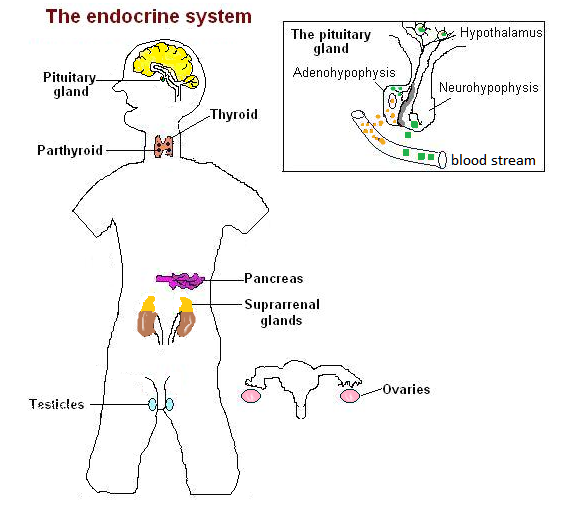Endocrine coordination is a mechanisme which regulates the actions of many of the body's organs, in a slow but prolonged manner.
It is carried out by the endocrine system, which is composed of a series of endocrine glands that produce and secrete hormones.
The endocrine system
The vertebrate endocrine system consists of more than a dozen glands. Some of these, such as the tyroid and the pituitary gland, are endocrine specialists; their main function is secreting hormones into the blood. Several other glands have both endocrine and nonendocrine functions. The pancres, for example, contains encocrine cells that secrete two hormones that influence the level of glucose in the blood. The pancreas also has nonendocrine cells that secrete digestive enzymes into the intestine via ducts.
The figure here shows the locations of the human endocrine glands.

There is a close association between the endocrine sytem and the nervious system. For example, the hypothalamus, which is part of the brain, secretes many hormones that regulate other endocrine glands, especially the pituitary (called also the hypophysis). We can obseve this association on the next drawing.
The hypotalamus is the master control center of the endocrine system. Its endocrine signals directly control the pituitary gland, which in turn secretes hormones that influence numerous body functions.
The hypothalamus receives information from nerves about the internal condition of the body and about external environment.
The hypothalamus exerts control over the anterior pituitary (adenohypophysis) by secreting two kinds of hormones into the blood. Releasing hormones make the anterior pituitary secrete hormones, and inhibiting hormones make the anterior pituitary stop secreting hormones.
The hypothalamus secretes TRH (TSH-releasing hormone), which in turn makes the anterior pituitary secrete TSH (thyroid-stimulating hormone). Under the influence of TSH, the thyroid secretes the hormone thyroxine into the blood. Thyroxine increases cellular respiration in most body cells, warming the body as a result.
When TSH and thyroxine increase in the blood, they inhibit TRH secretion. This negative feedback is important to keep the hormones at levels that maintain the homeostasis (the constant internal environment).
Endocrine glands and their hormones
| Gland |
Hormone |
Function |
|
Pituitary gland
(posterior pituitary)
|
Oxytocin
Antidiuretic hormone
(ADH)
|
Stimulates contraction of uterus and mammary glands cells
Promotes retention of water by kidneys
|
|
Pituitary gland
(anterior pituitary)
|
Growth hormone (GH)
Prolactine (PRL)
Follicle-stimulating hormone (FSH)
Luteinizing hormone (LH)
Thyroid-stimulating hormone (TSH)
Adrenocorticotropic hormone (ACTH)
|
Stimulates growth (specially bones) and metabolic functions
Stimulates milk production
Stimulates production of ova and sperm
Stimulates ovaries and testicles
Stimulates thyroid gland
Stimulates adrenal cortex to secrete glucocorticoids
|
| Thyroid gland |
Thyroxine
Calcitonina
|
Stimulates and maintains metabolic processes
Lowers blood calcium level
|
| Parathyroid glands |
Parathyroid hormone
(PTH)
|
Raises blood calcium level |
|
Adrenal glands
Adrenal medulla
Adrenal cortex
|
Adrenaline
Glucocorticoids
Mineralcorticoids
|
Increases blood glucose and metabolic activities
Increase blood glucose
Promote reabsorptio of Na+ and excretion of K+ in kidneys
|
| Pancreas |
Insulin
Glucagon
|
Lowers blood glucose
Raises blood glucose
|
|
Testicles
Ovaries
|
Androgens
Estrogens
Progesterone
|
Support sperm formation; development and maintenance of male secondary sex characteristics
Promotes uterine lining growth; development and maintenance of female secondary sex characteristics
Promotes uterine lining growth
|
You can check your knowledge about endocrine coordination here
Comments (1)
raul said
at 11:16 am on Mar 22, 2013
good page
You don't have permission to comment on this page.